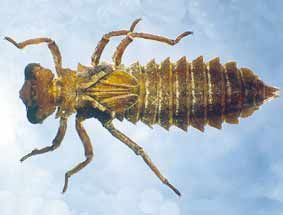Major Group: Insecta
Order: Odonata
Family: Archipetaliidae (formerly part of Neopetaliidae)
Genus: Archipetalia
Species: auriculata
This family is represented in Australia by a single species, Archipetalia auriculata Tillyard. |
Descriptive Features: prementum elongate, flat, lying below head when closed, setae absent
premental ligula trapezoidally produced, with well developed but short median cleft, at least 2 small denticles each side of it
labial palps evenly tapered and almost straight, denticulate but without end hook on inner margin, setae absent
no spine at the base of movable hook
antennae 4-segmented
prothoracic processes a distinctly trifid structure
pronotal lobes roughly trilobed
mesokatepisternum strongly produced laterally
a lateral spine on metathorax at the base of hind wing pads
femora with very small bumps
tibiae without bumps
tarsi of all legs 3-segmented
no distal tibial hooks or spurs
abdomen elongate, spine-like to subtriangular lateral lobes on segments 1-8, lacking on segment 9 which is armed with a rounded lateral "spine" each side
very small, middorsal tubercles on segments 3-9
very small to small laterodorsal lobes on segments 3-7
cerci subtriangular, approximately 1/3 length of epiproct
amour-like exoskeleton and broad lateral spines or subtriangular lobes on abdominal segments 2-8
Total length: 30 -34 mm |

|
Archipetalia auriculata |
|
|
|
Taxonomic Checklist:
Archipetalia auriculata Tillyard |
|
Distribution: Tas
Sensitivity Rating: none
Functional Feeding Group: predators |

|
Little Navarre River, Tas |
|
|
Ecology: Adults are commonly known as 'Tasmanian redspots'.
Instream habitat: Archipetalia auriculata larvae are semi-aquatic. They inhabit streams, boggy seepages and splash zones where they may be found associated with vegetation or under damp logs at the side of streams. Older larvae can be found further from permanent water.
Feeding ecology: Larvae are predators feeding on any other invertebrate life in their habitat.
Habit: Archipetalia auriculata larvae are strong climbers. They can pretend to be dead when threatened.
Life history: The larval phase may last for two years.
|
| |
Information Sources: Theischinger 2002, Houston 1988, Gooderham & Tsyrlin 2002, Theischinger & Hawking 2006 |
|
|
|